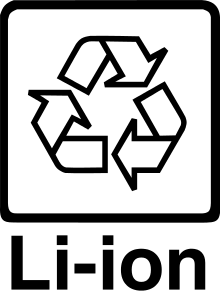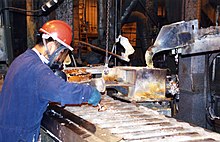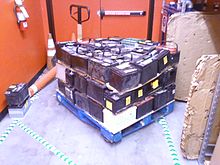电池回收

电池回收是一项回收活动,旨在减少电池被当做固体废物而被随意丢弃。废电池中含有大量的重金属以及有毒的化工废物;它们的随意丢弃造成了严重的土壤污染以及水污染.[1]
不同类型的电池回收
绝大部分的电池可被回收。但是,有些电池比其他的电池更容易回收些。比如说铅酸蓄电池(有近90%被回收)[2]和纽扣电池(因为它们具有较高的毒性)。[2]还有一些其他种类的电池,比如说碱性电池以及充电电池,包括镍镉电池(Ni-Cd)、镍氢电池(Ni-MH)、锂离子电池(Li-ion)和镍锌电池(Ni-Zn)都可以回收。
铅酸电池
铅酸电池主要用于各种汽车道,亦用于不斷電系統。回收方法是先对其进行大力挤压,之后将酸中和,再由铅里面回收聚合物。回收的产品有各种各样的用途,包括制作新电池。

也可以由铅酸电池内回收毒性很大的金属鉛,避免其污染水源。

很多城市都有铅酸电池的回收服务。比如美国的大部分州以及加拿大的大部分省,在当地,有许多将电池拿到废电池回收站的人从中获得收益,而且许多出售电池的地方都有回收电池的服务(有的是当地政府或者法律要求)。在美国,废旧的铅酸电池的回收率达到了97%。而中国就暂时没有相应的政策来鼓励民众回收铅酸电池。
银离子电池
这种电池主要用于手表、玩具及医学仪器等。里面有少量的汞。回收银离子电池可以去除毒性很大的汞,避免其污染环境。
不同种类电池的化学组成
斜体表示纽扣电池,粗体表示可充电电池,数据用百分比表示。
| 種類[3] | 铁 | 锰 | 镍 | 锌 | 汞 | 锂 | 银 | 镉 | 钴 | 铝 | 铅 | 其他金属 | 氢氧化钾 | 纸 | 塑膠 | 鹼 | 碳 | 酸 | 水 | 其它 |
|---|---|---|---|---|---|---|---|---|---|---|---|---|---|---|---|---|---|---|---|---|
| 鹼性電池 | 24.8 | 22.3 | 0.5 | 14.9 | 1.3 | 1 | 2.2 | 5.4 | 3.7 | 10.1 | 14 | |||||||||
| 碳锌电池 | 16.8 | 15 | 19.4 | 0.1 | 0.8 | 0.7 | 4 | 6 | 9.2 | 12.3 | 15.2 | |||||||||
| 锂电池 | 50 | 19 | 1 | 2 | 7 | 2 | 19 | |||||||||||||
| 水銀電池 | 37 | 1 | 1 | 14 | 31 | 2 | 3 | 1 | 3 | 7 | ||||||||||
| 锌空气电池 | 42 | 35 | 1 | 4 | 4 | 1 | 10 | 3 | ||||||||||||
| 锂电池 | 60 | 18 | 1 | 3 | 3 | 2 | 13 | |||||||||||||
| 鹼性電池 | 37 | 23 | 1 | 11 | 0.6 | 6 | 2 | 2 | 6 | 14 | ||||||||||
| 氧化銀電池 | 42 | 2 | 2 | 9 | 0.4 | 31 | 4 | 2 | 1 | 0.5 | 2 | 4 | ||||||||
| 鎳鎘電池 | 35 | 22 | 15 | 10 | 2 | 5 | 11 | |||||||||||||
| 镍氢电池 | 20 | 1 | 35 | 1 | 4 | 10 | 9 | 4 | 8 | 8 | ||||||||||
| 锂离子电池 | 22 | 3 | 18 | 5 | 11 | 13 | 28 | |||||||||||||
| 铅酸蓄电池 | 65 | 4 | 10 | 16 | 5 |
不同地区的电池回收情况
| 国家 | |
|---|---|
| 比利时 | 59% |
| 瑞典 | 55% |
| 奥地利 | 44% |
| 德国 | 39% |
| 荷兰 | 32% |
| 法国 | 16% |
| 英国 | 32%* |
*该数据是2012年第一、二季度数据。[4]
参见
参考文献
- ^ A. M. Bernardes, D. C. R. Espinosa, J. A. S. Tenorio. Recycling of batteries: a review of current processes and technologies. Journal of Power Sources. 2004-05-03, 130 (1–2): 291–298. ISSN 0378-7753. doi:10.1016/j.jpowsour.2003.12.026.
- ^ 2.0 2.1 Battery recycling in USA, United States Environmental Protection Agency, [9 September 2008], (原始内容存档于2004-02-25)
- ^ Fisher, Karen; Erika Wallén, Pieter Paul Laenen and Michael Collins, Battery Waste Management: Life Cycle Assessment (PDF), Environmental Resources Management, 18 Oct 2006, (原始内容 (PDF)存档于2013-10-08)
- ^ Date, Will. UK ‘on course’ to meet first battery collection target. letsrecycle.com. 19 September 2012 [2013-11-22]. (原始内容存档于2013-11-11).
扩展阅读
- G. Pistoia, J.-P. Wiaux and S.P. Wolsky (编). Used battery collection and recycling. Industrial Chemistry Library, Volume 10. Amsterdam: Elsevier Science. 2001. ISBN 0-444-50562-8.
外部链接
- 开放目录项目中的“电池回收”
- "Taking Batteries Green", ECN Magazine article from 2010
Text is available under the CC BY-SA 4.0 license; additional terms may apply.
Images, videos and audio are available under their respective licenses.
